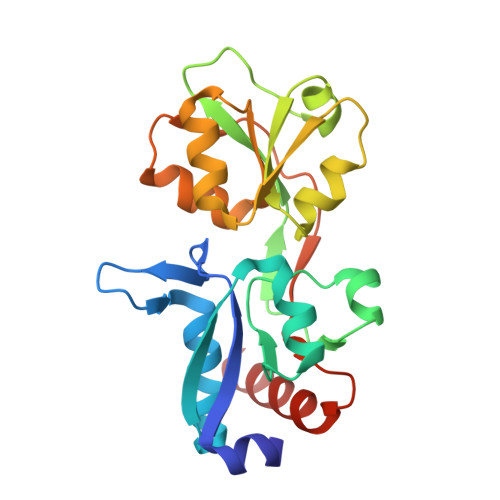Domain swapping dissection in Thermotoga maritima arginine binding protein: How structural flexibility may compensate destabilization.
Smaldone, G., Berisio, R., Balasco, N., D'Auria, S., Vitagliano, L., Ruggiero, A.(2018) Biochim Biophys Acta 1866: 952-962
- PubMed: 29860047
- DOI: https://doi.org/10.1016/j.bbapap.2018.05.016
- Primary Citation of Related Structures:
6GGP, 6GGV - PubMed Abstract:
Thermotoga maritima Arginine Binding Protein (TmArgBP) is a valuable candidate for arginine biosensing in diagnostics. This protein is endowed with unusual structural properties that include an extraordinary thermal/chemical stability, a domain swapped structure that undergoes large tertiary and quaternary structural transition, and the ability to form non-canonical oligomeric species. As the intrinsic stability of TmArgBP allows for extensive protein manipulations, we here dissected its structure in two parts: its main body deprived of the swapping fragment (TmArgBP 20-233 ) and the C-terminal peptide corresponding to the helical swapping element. Both elements have been characterized independently or in combination using a repertoire of biophysical/structural techniques. Present investigations clearly indicate that TmArgBP 20-233 represents a better scaffold for arginine sensing compared to the wild-type protein. Moreover, our data demonstrate that the ligand-free and the ligand-bound forms respond very differently to this helix deletion. This drastic perturbation has an important impact on the ligand-bound form of TmArgBP 20-233 stability whereas it barely affects its ligand-free state. The crystallographic structures of these forms provide a rationale to this puzzling observation. Indeed, the arginine-bound state is very rigid and virtually unchanged upon protein truncation. On the other hand, the flexible ligand-free TmArgBP 20-233 is able to adopt a novel state as a consequence of the helix deletion. Therefore, the flexibility of the ligand-free form endows this state with a remarkable robustness upon severe perturbations. In this scenario, TmArgBP dissection highlights an intriguing connection between destabilizing/stabilizing effects and the overall flexibility that could operate also in other proteins.
- IRCCS SDN, 80143 Napoli, Italy.
Organizational Affiliation:


















